Read and download free pdf of CBSE Class 10 Science Magnetic Effects Of Electric Current. Students and teachers of Class 10 Science can get free advanced study material, revision notes, sure shot questions and answers for Class 10 Science prepared as per the latest syllabus and examination guidelines in your school. Class 10 students should download this study material which will give them more knowledge for all chapters in Science and all important topics which are scoring and can get you more marks. Students should also download free pdf of Chapter wise Notes for Class 10 Science prepared by school teachers as per the latest NCERT, CBSE, KVS books and syllabus issued this year and also download free worksheets and question papers available here to get higher scores in school exams and tests, also click here for more Study Material for Class 10 Science
Study Material for Class 10 Science Chapter 12 Magnetic Effects of Electric Current
Class 10 Science students should refer to the following Pdf for Chapter 12 Magnetic Effects of Electric Current in Class 10. These notes and test paper with questions and answers for Class 10 Science will be very useful for exams and help you to score good marks
Class 10 Science Chapter 12 Magnetic Effects of Electric Current
Magnet is an object that attracts objects made of iron, cobalt & nickel.
When a magnet suspended freely it will align in North-South direction. Like poles repel each other and unlike poles attract each other
Magnets are used: (i) In radio & stereo speakers, (ii) In refrigerator doors, (iii) in audio & video cassettes players, (iv) in hard discs & floppies of computers & (v) in children„s toys.
Magnetic field: The area around a magnet where a magnetic force is experienced is called a magnetic field. It is a quantity that has both direction & magnitude.
Magnetic field lines: Magnetic field is represented by field lines. They are lines drawn in a Magnetic field along which a unit North magnetic pole moves. Magnetic field lines are called as Magnetic lines of force.
Properties of Magnetic field lines:
(i)They do not intersect each other. (ii)It is taken by convention that magnetic field lines emerge from North Pole and merge at the South Pole. Inside the magnet, their direction is from South Pole to North Pole. Therefore magnetic field lines are closed curves.
Magnetic field lines due to a current through a straight conductor (wire)- consist of series of concentric circles whose direction is given by the Right hand thumb rule.
Right hand thumb rule: If a current carrying straight conductor is held in your right hand such that the thumb points towards the direction of current, then the wrapped fingers show the direction of magnetic field lines.
Magnetic field lines due to a current through a circular loop
The strength of the magnetic field at the centre of the loop (coil)depends on:
(i)The radius of the coil- The strength of the magnetic field is inversely proportional to the radius of the coil. If the radius increases, the magnetic strength at the centre decreases. (ii)The number of turns in the coil: As the number of turns in the coil increase, the magnetic strength at the centre increases, because the current in each circular turn is having the same direction, thus the field due to each turn adds up. (iii)The strength of the current flowing in the coil: as the strength of the current increases, the strength of the magnetic fields also increases.
Solenoid:
(i) A coil of many turns of insulated copper wire wrapped in the shape of a cylinder is called a Solenoid. Magnetic field produced by a Solenoid is similar to a bar magnet.
The strength of magnetic field is proportional to the number of turns & magnitude of current.
Electromagnet: An electromagnet consists of a long coil of insulated copper wire wrapped on a soft iron core. (Refer to figure 13.11, page no. 229 of N.C.E.R.T Text book)
Fleming‘s Left hand rule: Stretch the thumb, forefinger and middle finger of left hand such that they are mutually perpendicular. Forefinger points in the direction of magnetic field and centre finger in the direction of current, then the thumb gives the direction of force acting on the conductor.
Electric motor: A device that converts electric energy to mechanical energy.
Principle of Electric motor: When a rectangular coil is placed in a magnetic field and a current is passed through it, force acts on the coil, which rotates it continuously. With the rotation of the coil, the shaft attached to it also rotates.
Electromagnetic induction: Electricity production as a result of magnetism (induced current) is called Electromagnetic induction. Fleming‘s Right hand rule: gives the direction of induced current. Stretch the thumb, forefinger and middle finger of right hand such that they are mutually perpendicular. Forefinger points in the direction of magnetic field and centre finger in the direction of induced current, then the thumb gives the direction of motion of the conductor.
Electric generator: A devise that converts mechanical energy to electric energy.
Electric generator is of two types- (i) A.C generator (ii) D. C generator
Principle of Electric generator: Electromagnetic induction
Domestic electric circuits: We receive electric supply through mains supported through the poles or cables. In our houses we
receive AC electric power of 220V with a frequency of 50Hz.
The 3 wires are as follows- (i) Live wire- (Red insulated, Positive) (ii)Neutral wire- (Black insulated, Negative) (iii)Earth wire- (Green insulated) for safety measure to
ensure that any leakage of current to a metallic body does not give any serious shock to a user.
Short circuit: is caused by touching of live wires and neutral wire
Fuse: is a protective device used for protecting the circuits from short circuiting and over loading
Question. A plotting compass is placed near the south pole of a bar magnet. The pointer of plotting compass will:
(a) point away from the south pole
(b) point parallel to the south pole
(c) point towards the south pole
(d) point at right angles to the south pole
Answer. C
Question. A strong bar magnet is placed vertically above a horizontal wooden board. The magnetic lines of force will be:
(a) only in horizontal plane around the magnet
(b) only in vertical plane around the magnet
(c) in horizontal as well as in vertical planes around the magnet
(d) in all the planes around the magnet
Answer. D
Question. Which of the following is not attracted by a magnet?
(a) steel
(b) cobalt
(c) brass
(d) nickel
Answer. C
Question. Which of the following statements is incorrect regarding magnetic field lines?
(a) The direction of magnetic field at a point is taken to be the direction in which the north pole of a magnetic compass needle points.
(b) Magnetic field lines are closed curves.
(c) If magnetic field lines are parallel and equidistant, they represent zero field strength.
(d) Relative strength of magnetic field is shown by the degree of closeness of the field lines.
Answer. C
Question. Assertion (A): As the speed of the coil in the motor increases, there is reduction in the current flowing through it.
Reason (R): During rotation in electric motor, some induced current is produced.
(a) (A) is incorrect and (R) is correct.
(b) (A) is correct and (R) is incorrect.
(c) Both (A) and (R) are correct but (R) is not the correct explanation of (A).
(d) Both (A) and (R) are correct but (R) is the correct explanation of (A).
Answer. D
Fill in the following blanks with suitable words:
Question. The magnetic effect of a coil can be increased by increasing the number of.............., increasing the ............., or inserting an..............core.
Answer. Turns in the coil, current flow, soft iron.
Question. The two main organs of the human body where the magnetic field produced is quite significant are the………. and the………….
Answer. Heart, brain
Question. If a coil is viewed from one end, and the current flows in a clockwise direction, then this end is a .............pole.
Answer. South
Question. If a coil is viewed from one end and the current flows in an anticlockwise direction, then this end is a.........pole.
Answer. North
CBSE Class 10 Science Chapter 13 Magnetic Effects Of Electric Current Very Short Answer Type Questions
Question. State the effect of a magnetic field on the path of a moving charged particle.
Answer. A charged particle moving in a magnetic field may experience a force in the direction perpendicular to direction of magnetic field and direction of motion of particle. This force deflects the charged particle from its path.
Question. What is the function of a galvanometer in a circuit?
Answer. Galvanometer is an instrument that can detect the presence of electric current in a circuit.
Question. What is meant by magnetic field?
Answer. Magnetic field : It is defined as the space surrounding the magnet in which magnetic force can be experienced.
Question. State the direction of magnetic field in the following case.

Answer. Using Fleming’s left hand rule, the direction of magnetic field is into the plane of paper.
Question. A charged particle enters at right angle into a uniform magnetic field as shown. What should be the nature of charge on the particle if it begins to move in a direction pointing vertically out of the page due to its interaction with the magnetic field?
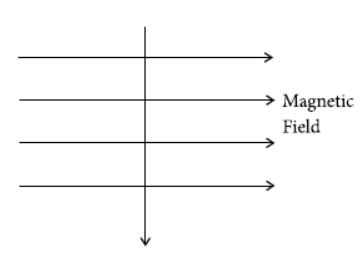
Answer. By using Fleming’s left hand rule if the direction of motion of charged particle is vertically out of the page, then the charged particle must be positive in nature.
Question. State two ways by which the speed of rotation of an electric motor can be increased.
Answer. The speed of rotation of an electric motor can be increased by
(i) increasing the strength of the current
(ii) increasing the number of turns in the coil.
Question. Which sources produce alternating current?
Answer. AC generator, Thermal power station, Hydro-electric station.
Question. Why does a compass needle get deflected when brought near a bar magnet ?
Answer. A compass needle gets deflected when brought near a bar magnet because magnetic force is exerted by the bar magnet on the compass needle, which is itself a tiny pivoted magnet.
Question. Name the factors on which strength of an electromagnet depend.
Answer. The strength of an electromagnet depends on the following factors :
(a) Number of the turns in the coil
(b) Strength of the current
(c) Nature of the core material.
Question. What is the role of the split ring in an electric motor ?
Answer. Split ring facilitates the contacts with the ends of the rectangular coil to keep the rotation continuous and not a reversal after every 180°.
CBSE Class 10 Science Chapter 13 Magnetic Effects Of Electric Current Short Answer Type Questions
Question. straight current carrying conductor at a point depends on (a) current through the conductor (b) distance of point from conductor.
Answer. Strength of magnetic field produced by a straight currentcarrying
wire at a given point is
(a) directly proportional to the current passing through it.
(b) inversely proportional to the distance of that point from
the wire.
i.e., B ∝I/r
B → magnetic field
I → current
r → distance between wire and
point of observation
Question. What is a solenoid? Draw the pattern of magnetic field lines of a solenoid through which a steady current flows. What does the pattern of field lines inside the solenoid indicate?
Answer. Solenoid : A coil of many circular turns of insulated copper
wire wrapped in the shape of cylinder is called solenoid.
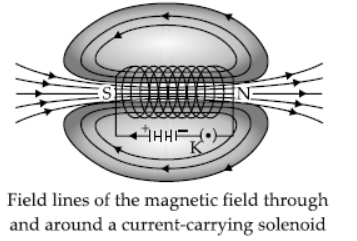
The pattern of magnetic field lines inside the solenoid indicates that the magnetic field is the same at all points inside the solenoid. That is, the field is uniform inside the solenoid.
Question. Write any one method to induce current in a coil.
Answer. By keeping the magnet in a fixed position and moving the coil towards and away from the magnet, we can induce current in the coil.
Question. It is established that an electric current through a metallic conductor produces a magnetic field around it. Is there a similar magnetic field produced around a thin beam of moving (i) alpha particles, (ii) neutrons? Justify your answer.
Answer. (i) Yes, alpha particles being positively charged constitutes a current in the direction of motion.
(ii) No, the neutrons being electrically neutral constitute no current.
Question. What does the divergence of magnetic field lines near the ends of a current carrying straight solenoid indicate?
Answer. The divergence, that is, the falling degree of closeness of magnetic field lines indicated the fall in strength of magnetic field near and beyond the ends of the solenoid.
Question. In what respect does a wire carrying a current differ from a wire, which carries no current?
Answer. A current carrying wire produces a magnetic field. When current is flowing through a wire, the electrons move inside it along a definite direction. On the other hand, if no current is flowing through a wire, the electrons inside this wire are in random motion, their average thermal velocity is zero. Such a wire does not produce any magnetic field.
Question. What is the direction of the force that a vertical magnetic field, directed upward, will exert on an electron travelling eastward in it?
Answer. Applying Fleming’s left hand rule point your fore finger upward. Since you are dealing with a negative charge, rotate your hand until the middle finger points east. Your thumb will point northward, and that is the direction of the force.
Question. Why does a current-carrying wire move when placed in magnetic field ?
Answer. A current-carrying wire produces a magnetic field around it. When placed in a magnetic field, the two magnetic fields interact with each other and the wire moves.
Question. An electron enters a magnetic field at right angle to it as shown in the figure. What is the direction of force acting on the electron?

Answer. The direction of force is at right angle to the direction of magnetic field and current (opposite to the direction of motion of electrons). Applying Fleming’s left-hand rule, the force is at right angle into the page.
Question. In the diagram, A and B represent two straight wires carrying equal currents in a direction at right angle to the paper and downward into the paper. Sketch separately the magnetic lines of force produced by each current carrying conductor. Give reason why the magnetic field at K will be zero.
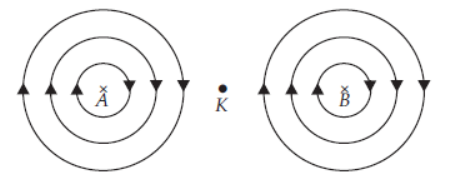
Answer. 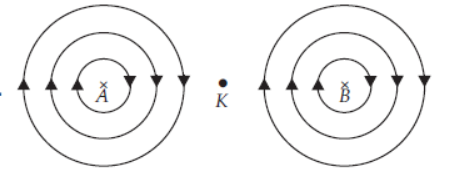
Figure shows the sketch of magnetic lines of force produced by current in wires A and B.
The point K is equidistant from the wires A and B, the wires A and B carry equal current, so the magnetic fields at K due to wires A and B are equal in magnitude but opposite in direction. Magnetic field due to the wire A is downward to the plane of paper, while due to the wire B it is upward to the plane of paper. So the net magnetic field at K is zero.
CBSE Class 10 Science Chapter 13 Magnetic Effects Of Electric Current Short Answer Type Questions
Question. A coil of insulated wire is connected to a galvanometer. What would be seen if a bar magnet with its north pole towards one face of the coil is
(i) moved quickly towards it,
(ii) placed near its one face?
Answer. If a coil of insulated wire is connected to a galvanometer
and a bar magnet with north pole is moved towards one face of the coil then, given situation is shown in the figure.
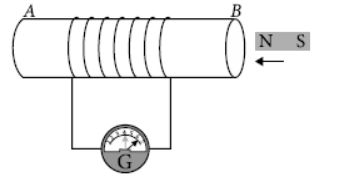
(i) Moved quickly towards the coil : A current is induced in anti-clockwise direction in the coil with respect to the side facing the south pole of the magnet and needle of galvanometer will deflect in one direction from zero position.
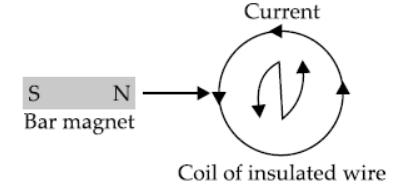
(ii) Placed near its one face : No deflection of the needle of galvanometer is observed.
Question. In Faraday’s experiment if instead of moving the magnet towards the coil we move the coil towards the magnet. Will there be any induced current? Justify your answer. Compare the two cases.
Answer. Yes, these will be an induced current in both the cases as there is a change in the number of magnetic field lines associated with the coil or we can say that there is a motion of a magnet with respect to the coil.
Same current will be induced and the direction of flow of current will also be the same in the two cases.
Question. (a) State Right Hand Thumb rule to find the direction of the magnetic field around a current carrying straight conductor.
(b) How will the magnetic field be affected on:
(i) increasing the current through the conductor
(ii) reversing the direction of flow of current in the conductor?
Answer. (a) It states that you are holding a current carrying straight conductor in your right hand such that the thumb points towards the direction of current. Then your finger will
wrap around the conductor in the direction of the field lines of the magnetic field.
(b) (i) If the current is increased, the magnetic field strength also increases.
(ii) If the direction of current is reversed, the direction of magnetic field also get reversed.
Question. Diagram shows the lengthwise section of a current carrying solenoid. ⊗ indicates current entering into the page, indicates current emerging out of the page. Decide which end of the solenoid A or B, will behave as north pole.
Give reason for your answer. Also draw field lines inside the solenoid.
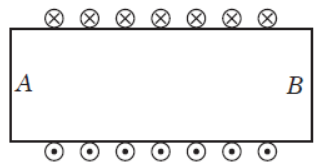
Answer. 
Using right hand thumb rube we can draw the magnetic field lines around the conductor as shown.
From figure, end A of solenoid act as north pole and end B will act as south pole. Inside the solenoid field lines are in the form of parallel straight lines.
Question. Find the direction of magnetic field at centre of current carrying circular coil held:
(i) vertically in North - South plane and an observer looking it from east sees the current to flow in anticlockwise direction,
(ii) in East - West plane and an observer looking it from south sees the current to flow in anticlockwise direction,
(iii) horizontally and an observer looking at it from below sees current to flow in clockwise direction.
Answer. According to right hand rule, the direction of magnetic field is
(i) west to east (ii) north to south
(iii) vertically upwards.
Question. Two circular coils P and Q are kept close to each other, of which coil P carries a current. What will you observe in the galvanometer connected across the coil Q
(a) if current in the coil P is changed?
(b) if both the coils are moved in the same direction with the same speed?
Give reason to justify your answer in each case.
Answer. a) When the amount of current in the coil P is changed, an induced current will induce in the coil Q due to change in magnetic field lines i.e., magnetic flux.
(b) If both the coils are moved in the same direction with the same speed, then there is no net change in magnetic flux.Hence there will be no deflection in the galvanometer.
Question. Imagine that you are sitting in a chamber with your back to one wall. An electron beam, moving horizontally from back wall towards the front wall, is deflected by a strong magnetic field to your right side. What is the direction of the magnetic field?
Answer. The direction of current I is opposite to the direction electron beam as shown in figure. Since the beam is deflected to the right side, the force, F acting on the beam is as shown. Applying Fleming’s left hand rule, it is found that magnetic field, B is acting vertically downwards (i.e., perpendicular to the plane of the paper and directed inwards) as shown by ⊗.
Question. A rectangular coil ABCD is placed between the pole pieces of a horse-shoe magnet as shown in figure.

(i) What is the direction of force on each arm?
(ii) What is the effect of the forces on the coil?
(iii) How is the effect of force on the coil changed if the terminals of the battery are interchanged ?
Direction : Read the passage and answer the following questions given below:
The strength of the magnetic field produced by a current-carrying circular coil (or circular wire) depends on (i) Current flowing through the coil.
(ii) Radius of the circular coil. (iii) Number of turns of wire in the circular coil.
Answer. (i) In figure, the current in the coil is in direction DCBA. By Fleming’s left hand rule, in the arm AB, the force is outward at right angle to the plane of the coil. On the arm BC no force acts. On the arm CD, the force is inwards perpendicular to the plane of the coil. On the arm DA, no force acts.
(ii) The force on the arms AB and CD are equal in magnitude, but opposite in direction. They form a clockwise couple. So the coil will rotate clockwise with the arm AB coming out and the arm CD going in.
(iii) On interchanging the terminals of the battery, the coil will rotate anticlockwise.
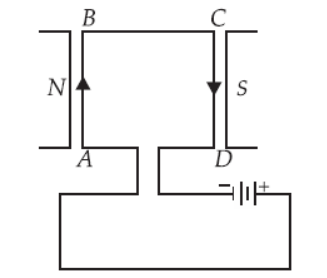
Question. A circular coil is carrying a current of 100 A in the anti clockwise when seen from upward direction. Find the pole of magnetic field when seen from 1.0 m below.
Answer. The pole of magnetic field will be south pole below the power line.
Question. What type of curves we get, between magnetic field and distance along the axis of a current carrying circular coil ?
Answer. At smaller distances, the magnetic field will be described by concentric circles around the wire. As the distance increases, the circles become larger and larger. At the centre of the loop/ coil, the magnetic field will appear as straight line.
Question. If a current carrying straight conductor is placed is east-west direction, then find the direction of the force experienced by the conductor due to earth’s magnetic field.
Answer. The force will act in upward direction perpendicular to both, the direction of current as well as to the field.
CBSE Class 10 Science Chapter 13 Magnetic Effects Of Electric Current Long Answer Type Questions
Question. A current carrying conductor is placed in a magnetic field now answer the following.
(i) List the factors on which the magnitude of force experienced by conductor depends.
(ii) When is the magnitude of this force maximum?
(iii) State the rule which helps in finding the direction of motion of conductor.
(iv) If initially this force was acting from right to left, how will the direction of force change if:
(a) direction of magnetic field is reversed?
(b) direction of current is reversed?
Answer. (i) When a current carrying wire is placed in a magnetic field, it experiences a magnetic force that depends on
(a) current flowing in the conductor
(b) strength of magnetic field
(c) length of the conductor
(d) angle between the element of length and the magnetic field.
(ii) Force experienced by a current carrying conductor placed in a magnetic field is largest when the direction of current is perpendicular to the direction of magnetic field.
(iii) The rule used in finding the direction of motion of the conductor placed in a magnetic field is Fleming’s left hand rule.
Fleming’s left hand rule is as follows:
Stretch out the thumb, the forefinger, and the second (middle) finger of the left hand so that these are at right angles to each other. If the forefinger gives the direction of the magnetic field (N to S), the second (middle) finger the direction of current then the thumb gives the direction of the force acting on the conductor.
(iv) (a) Direction of force will be reversed when direction of magnetic field is reversed, i.e., now force on conductor will act from left to right.
(b) Direction of force will be reversed, if the direction of current is reversed, i.e., the force on the conductor will act from left to right.
Question. (a) A coil of insulated copper wire is connected to a galvanometer. With the help of a labelled diagram state what would be seen if a bar magnet with its south pole towards one face of this coil is
(i) moved quickly towards it,
(ii) moved quickly away from it,
(iii) placed near its one face?
(b) Name the phenomena involved in the above cases.
(c) State Fleming’s right hand rule.
Answer. (a) If a coil of insulated wire is connected to a galvanometer and a bar magnet with south pole is moved towards one face of the coil then, given situation is shown in the figure.
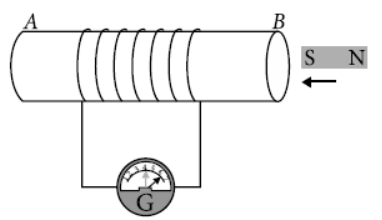
(i) Moved quickly towards the coil : A current is induced in clockwise direction in the coil with respect to the side facing the north pole of the magnet and needle of galvanometer will deflect in one direction from zero position.
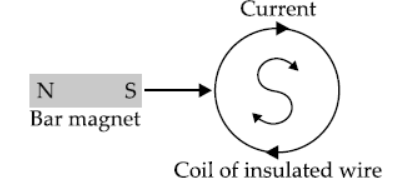
(ii) Moved quickly away from coil : A current is induced in anti-clockwise direction in the coil with respect to the side facing the north pole of the magnet and the needle of the galvanometer will deflect in opposite direction from (i).
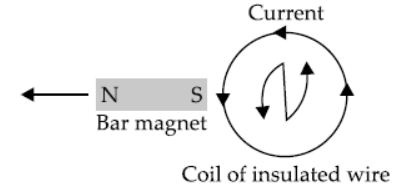
(iii) Placed near its one face : No deflection of the needle of galvanometer is observed.
(b) The phenomena involved is called electromagnetic induction.
(c) Fleming’s right hand rule: Stretch the right hand such that the first finger, the central finger and the thumb are mutually perpendicular to each other. If the first finger points along the direction of the field (magnetic field) and the thumb points along the direction of motion of the conductor, then the direction of induced current is given by the direction of the central finger.
Question. Define magnetic field lines. Describe an activity to draw a magnetic field line outside a bar magnet from one pole to another pole.
Answer: The path traced by a north magnetic pole free to move under the influence of a magnetic field is called a magnetic field line.
The bar magnet M whose magnetic field pattern is to be traced is placed on a sheet of paper and its boundary is marked with a pencil (see Figure 7). A plotting compass is now brought near the N-pole
of the bar magnet (see position X in Figure 7). In this position, the N-pole of magnet repels the npole of compass needle due to which the tip of the compass needle moves away from the N-pole of the magnet. On the other hand, the N-pole of magnet attracts the s-pole of compass needle due to which the tail of compass needle comes near the N-pole of the magnet (see position X in Figure 7).
We mark the positions of the tip and the tail of compass needle by pencil dots B and A. That is, we mark the positions of the two poles of the compass needle by pencil dots B and A (tip representing north pole and tail representing south pole).
We now move the compass to position Y so that the tail of compass needle (or south pole) points at dot B (previously occupied by n-pole of compass needle). We mark a dot C at the tip of the compass needle to show the position of its north pole. In this manner we go on step by step till we reach the south pole of the magnet. By doing this we get the various dots A, B, C, D, E, F, G, H, I, J, K and L, all denoting the path in which the north pole of the compass needle moves. By joining the various dots, we get a smooth curve representing a magnetic field line, which begins on the north pole of the bar magnet and ends on its south pole (see Figure 7). We can draw a large number of lines of force in the same way by starting from different points near the magnet. Every line is labelled with an arrow to indicate its direction. In this way we will get the complete pattern of the magnetic field around a bar magnet.
Question. (a) The diagram shows a bar magnet surrounded by four plotting compasses. Copy the diagram and mark in it the direction of the compass needle for each of the cases B, C and D.
(b) Which is the north pole, X or Y?
Answer. (a) In B and D, needle points towards right. In C, needle points towards left.
(b) North -X
Question. Describe an activity with labelled diagram to show that a force acts on current carrying conductor placed in a magnetic field and its direction of current through conductor. Name the rule which determines the direction of this force.
Answer. A small aluminium rod suspended horizontally from a stand using two connecting wires. Place a strong horseshoe magnet in such a way that the rod lies between the two poles with the magnetic field directed upwards. For this, put the north pole of the magnet vertically below and south pole vertically above the aluminium rod.
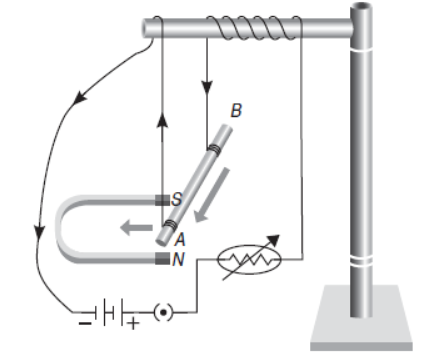
Connect the aluminium rod in series with a battery, a key and a rheostat. Pass a current through the aluminium rod from one end to other (B to A). The rod is displaced towards left. When the direction of current flowing through the rod is reversed, the displacement of rod will be towards right. Direction of force on a current carrying conductor is determined by Fleming’s left hand rule.
Question. (a) Draw the magnetic lines of force due to a circular wire carrying current.
(b) What are the various ways in which the strength of magnetic field produced by a currentcarrying circular coil can be increased?
Answer.
(b) The magnitude of magnetic field produced by a current carrying coil at a given point is:
(i) directly proportional to the current passing through the circular loop (or circular wire), and
(ii) inversely proportional to the radius of circular loop (or circular wire).
Question. Two coils of insulated copper wire are wound over a non-conducting cylinder as shown. Coil 1 has comparative large number of turns. State your observations, when
(i) Key K is closed.
(ii) Key K is opened.
Give reason for each of your observations.
Answer. (i) When key K is closed, a momentary deflection is shown by the galvanometer.
(ii) When key is opened, a momentary deflection in shown by the galvanometer but in the opposite direction.
Reason: When key is closed or opened, the current in the coil I changes and hence the magnetic field associated with it also changes. Thus, the magnetic field lines around the coil II also change.
Hence the change in magnetic field lines associated with the coil II is the cause of induced electric current in it.
Question. What is a solenoid? Draw a diagram to show field lines of the magnetic field through and around a current carrying solenoid. State the use of magnetic field produced inside a solenoid. List two properties of magnetic lines of force.
Answer. Solenoid : A coil of many circular turns of insulated copper wire wrapped in the shape of cylinder is called solenoid.
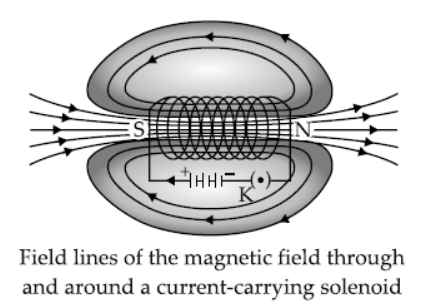
The pattern of magnetic field lines inside the solenoid indicates that the magnetic field is the same at all points inside the solenoid. That is, the field is uniform inside the solenoid.
Solenoid is used to form strong but temporary magnet called electromagnets. These electromagnets are used in wide variety of instruments and used to lift heavy iron objects.
(a) Two magnetic field lines never intersect each other.
(b) Magnetic field are closed curves.
Question. (i) With the help of an activity, explain the method of inducing electric current in a coil with a moving magnet. State the rule used to find the direction of electric current thus generated in the coil.
(ii) Two circular coils P and Q are kept close to each other, of which coil P carries a current.
What will you observe in Q
(a) if current in the coil P is changed?
(b) if both the coils are moved in the same direction with the same speed? Give reason.
Answer. (i) Take a coil AB of wire having a large number of turns.
Connect the ends of coil to a sensitive galvanometer as shown in figure.
Take a strong bar magnet and move its north pole towards the end ‘A’ of coil. The deflection in the needle of galvanometer indicates that the induced current flows in the circuit in
anticlockwise direction. The end A of the coil behaves as a north pole.
When north pole of the magnet moves away from the coil, the deflection in the galvanometer occurs but in opposite direction.
Similar observations can be made when south pole of the magnet is moved towards the coil or away from it.
When magnet is kept at rest with respect to the coil, the deflection in the needle of galvanometer drops to zero.
Thus, the motion of a magnet, with respect to the coil, produces an induced potential difference which sets up an induced electric current in the circuit.
The direction of electric current thus generated in the coil can be found by using the Fleming’s right-hand rule.
(ii) Fleming’s right-hand rule: Stretch the thumb, forefinger and middle finger of right hand in such a way that they are mutually perpendicular to each other. If the forefinger indicates the direction of magnetic field and thumb shows the direction of motion of the conductor, then the middle finger will indicate the direction of induced current.
(a) If current in the coil P is changed, the magnetic field lines of forces linked with coil Q also change. So, induced potential difference is set up in the coil Q. This results in induced electric current in coil Q which opposes the change in current in coil P.
(b) If both the coils are moved in the same direction with the same speed, there will be no relative motion between them and hence, there will be no change in magnetic field lines of force associated with the secondary coil. Hence, no current will be induced in the coil.
Question. State and explain the Clock face rule for determining the polarities of a circular wire carrying current.
Answer. According to Clock face rule, look at one face of a circular wire (or coil) through which a current is passing:
(i) if the current around the face of circular wire (or coil) flows in the Clockwise direction, then that face of the circular wire (or coil) will be South pole (S-pole).
(ii) if the current around the face of circular wire (or coil) flows in the Anticlockwise direction, then that face of circular wire (or coil) will be a North pole (N-pole)
Question. Two coils C1 and C2are wrapped around a non-conducting cylinder. Coil C1is connected to a battery and key and C2 with galvanometer G. On pressing the key (K), current starts flowing in the coil C1State your observation in the galvanometer:
(i) When key K is pressed on
(ii) When current in the coil C1 is switched off.
(iii) When the current is passed continuously through coil C1
(iv) Name and state the phenomenon responsible for the above observation. Write the name of the rule that is used to determine the direction of current produced in the phenomena.
Answer. (i) When key is pressed on, the galvanometer needle deflects momentarily in one direction.
(ii) When the current in the coil C1 is switched off, the galvanometer needle deflects again momentarily but in opposite direction to that in the previous case.
(iii) When current is passed continuously through coil C1 , no deflection is observed in the galvanometer.
(iv) The phenomenon responsible for the above observations is electromagnetic induction.
Electromagnetic Induction: The process, by which a changing magnetic field in a conductor induces a current in another conductor placed nearby, is called electromagnetic induction.
• Fleming’s right hand rule is used to determine the direction of current produced in the phenomena of electromagnetic induction.
Question. Distinguish between a solenoid and a bar magnet. Draw the magnetic lines for both
Answer.
The solenoid is a long coil containing a large number of close turns of insulated copper wire.
The magnetic field produced by the current carrying solenoid is similar to the magnetic field produced by a bar magnet. A solenoid is used for making electromagnets.
Differences between a bar magnet and solenoid:
Bar magnet
It is a permanent magnet.
The strength of a bar magnet cannot be changed.
The polarity (North – South) of a bar magnet cannot be changed.
Solenoid
It is a temporary magnet. It acts as a magnet only as long as the current passes through it.
The strength of a solenoid can be changed by changing the number of turns in its coil or by changing the current passing through it.
The polarity of a solenoid can be changed by changing the direction of current in its coil.
Very Short Answer Type Questions
Q.1What is a solenoid?
Q.2What is the direction of the magnetic field lines inside a bar magnet?
Q.3What is the direction of the magnetic field lines outside a bar magnet?
Short Answer Type Questions
Q.1What is an electromagnet?
Q.2What is the difference between a direct current and an alternating current? What is the frequency of AC in India?
Q.3 State the rule to find the direction of magnetic field produced around a current-carrying conductor.
Short Answer Type Questions
Q.1What is the role of fuse, used in series with any electrical appliance? Why should a fuse with defined rating not be replaced by one with a larger rating?
Q.2 Why does a magnetic compass needle deflect when a bar magnet or a current-carrying loop is brought near it.
Value Based Question
The students of class 10th were excited as they were shown a documentary on “power consumption” during a Science Fair. The documentary explained that we use Alternating Current in our home and factory which is dangerous if not handled properly. Short circuiting and overloading are the two main causes for electrical hazards. Short circuiting occurs when the live wire and the neutral wire
Please click the link below to download CBSE Class 10 Science-Magnetic Effects Of Electric Current.
| CBSE Class 10 Science Electricity |
| CBSE Class 10 Science Electricity Notes |
| CBSE Class 10 Science Electricity Sure Shot Questions A |
| Class 10 Science Electricity Exam Notes |
CBSE Class 10 Science Chapter 12 Magnetic Effects of Electric Current Study Material
We hope students liked the above Study Material for Chapter 12 Magnetic Effects of Electric Current designed as per the latest syllabus for Class 10 Science released by CBSE. Students of Class 10 should download the Study Material in Pdf format, read the notes and related questions and solutions given in above Class 10 Science Study Material on daily basis. All latest Study Material have been developed for Science by referring to the most important and regularly asked topics which the students should learn and practice to get better score in school tests and examinations. Expert teachers of studiestoday have referred to NCERT book for Class 10 Science to develop the Science Class 10 Study Material. After solving the questions given in the Study Material which have been developed as per latest course books also refer to the NCERT solutions for Class 10 Science designed by our teachers. Also download Class 10 Science Sample Papers given on studiestoday. After solving these you should also refer to Class 10 Science MCQ Test for the same chapter.
You can download free study material for Class 10 Science Chapter 12 Magnetic Effects of Electric Current for latest academic session from StudiesToday.com
Yes, the study material given here for Class 10 Science Chapter 12 Magnetic Effects of Electric Current is for current CBSE session
All study maetrial for CBSE Class 10 Science Chapter 12 Magnetic Effects of Electric Current is free

